
© Kyle Morck. (Click image for larger version)
Trey McIntyre’s The Big Hunger for San Francisco Ballet
premieres on 13 February 2020. Part of the Dance Innovations bill. Full Details
The third time may be a charm of sorts for choreographer Trey McIntyre. His first two commissions for San Francisco Ballet – Presentce, created for the 2017 season-opening gala, and Your Flesh Shall Be a Great Poem, commissioned for 2018’s Unbound: A Festival of New Works – were critical and audience hits, but his third company commission is far more ambitious than either of them: Titled The Big Hunger, the 30-minute work is set to Prokofiev’s blistering Piano Concerto No. 2 in G Minor, a piece so technically challenging that only a handful of pianists worldwide can meet its demands. In fact, S.F. Ballet has engaged 2017 Van Cliburn Gold Medal winner Yekwon Sunwoo to play for all seven performances.
McIntyre’s choreography is as electrifying as the music. In an August 2019 rehearsal, principal dancers Dores André, Benjamin Freemantle, Jennifer Stahl and Luke Ingham dug deep to execute the blazingly fast and acrobatic movement. And yet, while The Big Hunger taps every ounce of physical energy and mental focus the dancers command, the steps flow with uncanny smoothness because they were created on their bodies, and in many instances are wholly unique to their physical qualities and their creativity.
It will be something to witness when McIntyre’s imagination, the dancers’ artistry and Yekwon’s musical interpretation come together at the premiere of The Big Hunger on 13 February, as part of the “Dance Innovations” triple bill that also includes Edwaard Liang’s 2018 The Infinite Ocean and Harald Lander’s 1948 Études. By phone after the August rehearsal, McIntyre delved into his personal and artistic inspirations for the work…

© Erik Tomasson. (Click image for larger version)
Thank you for letting me sit in on rehearsal. It’s a thrilling piece, but it was exhausting to watch! What was your inspiration?
A couple of different elements came together at once. I was in Australia, and I was thinking about starting to adjust from focusing so squarely on pop music to more orchestral scores. I spoke to Nigel Gaynor, {music director and principal conductor of Queensland Ballet), and he suggested this Prokofiev score. I immediately thought it was one of the best things I’ve ever heard. About the same time, I saw a film (Lee Chang-dong’s 2018 Burning), and one of the characters brought up this notion of the Big Hunger versus the Little Hunger. It articulated something that I had been wrestling with, which was continuing to be duped that all the small things in life are the big things in life. The idea is that there are these two hungers that we have in life: the Little Hunger being quite literally the hunger for food – but in this piece it’s the hunger for the minutiae – whereas the Big Hunger is the hunger for meaning.
What I wanted to do in the piece is kind of break apart the ways that we invest these little things with big importance, and how finite these little things are, and how they all die, and how they all break eventually. Whether it be romantic love, or whether it be about pushing the boundaries of what’s physically possible in dance, or whether it be about technique, you can push and push and push, but finally there’s just an end to it. And the bigger part is what lies beyond that.
It’s certainly true the expression of a dancer’s soul is not dependent on their technique. Even people who have no technique can express themselves beautifully through movement.
For sure. And I really kept seeing the idea within all of the things we invest in as a ballet company. We become so self-important, because technique is so difficult, and you’re striving for more and more perfection. That myopic focus gets bigger and bigger and bigger, and it becomes very easy to forget that it’s still just ballet technique, and there’s a whole other facet to it. Somebody could be a much more compelling performer because, like what you just said, the greater consciousness, and what the truth is, may be coming out of them in a way that has nothing to do with ballet technique.

© Erik Tomasson. (Click image for larger version)
There’s a way you have with musicality, and with pauses in the phrasing – it’s beautiful and compelling. I saw that in Your Flesh Shall Be a Great Poem.
Thank you. I think this is why I’m so meticulous about the music that I work with. It’s partially to do with my musical background. But I always feel like I’ve got to have something to offer beyond merely showing the music through movement. Because the music has already done that, and it would just be exploitative. (Prokofiev’s Piano Concerto No. 2) was quite intimidating in that way, because it’s so complex and it operates on so many different levels at once.
What does it take for an orchestral piece to be danceable?
What the conversation (with Nigel) involved was, it’s more commonly going to be a concerto, just because of the variance in it. There’s more of a story when we’re moving in and out of the relationship between the main voice, the piano, and then the adventure that the orchestra takes you on. It’s gonna be a little less formulaic, generally.
The tempo of the final section of this concerto is allegro tempestoso!
The poor pianist in rehearsal – it’s such a beast, and she’s been trying to play it, but it’s the kind of piece that would take a year to work on it. I’ve been trying to go back and forth from the recording to the live piano, just so that the dancers don’t get used to hearing one particular version. Pianists have all the Prokofiev concertos in their repertoire, but not the second one! [laughs]
For you as a trained pianist, do you understand this piece of music in a unique way?
The thing that’s benefitted me more than anything is to be able to sit with the score in front of me. I don’t think it would have been possible just by ear to really understand it. And there were certain times when the playing is so intense, it would take me a while to read it because I couldn’t imagine there were that many notes in a measure. I’ll go to the symphony but seeing the players is not that interesting to me, but I’m addicted to watching YouTube videos of people playing this. It’s so emotional, they really act the piece with their body, because I think it’s the only way.
You’re really pushing the dancers to the limit of their endurance and their speed, and there’s gymnastics and daredevilry going on. I think it works because you have dancers with the ability to do those things. But sometimes a choreographer has a vision of doing that sort of thing, and it’s beyond what the dancers are capable of. But you’re pushing dancers who can go there.
It has everything to do with, ‘These are the dancers I’m working with.’ It would have gone in a different direction with different dancers. The idea speaks directly to Dores and Benjamin in that way. They were hungry for more. ‘What’s the idea? We can’t wait to try it.’ I thought, why not lean completely into that.
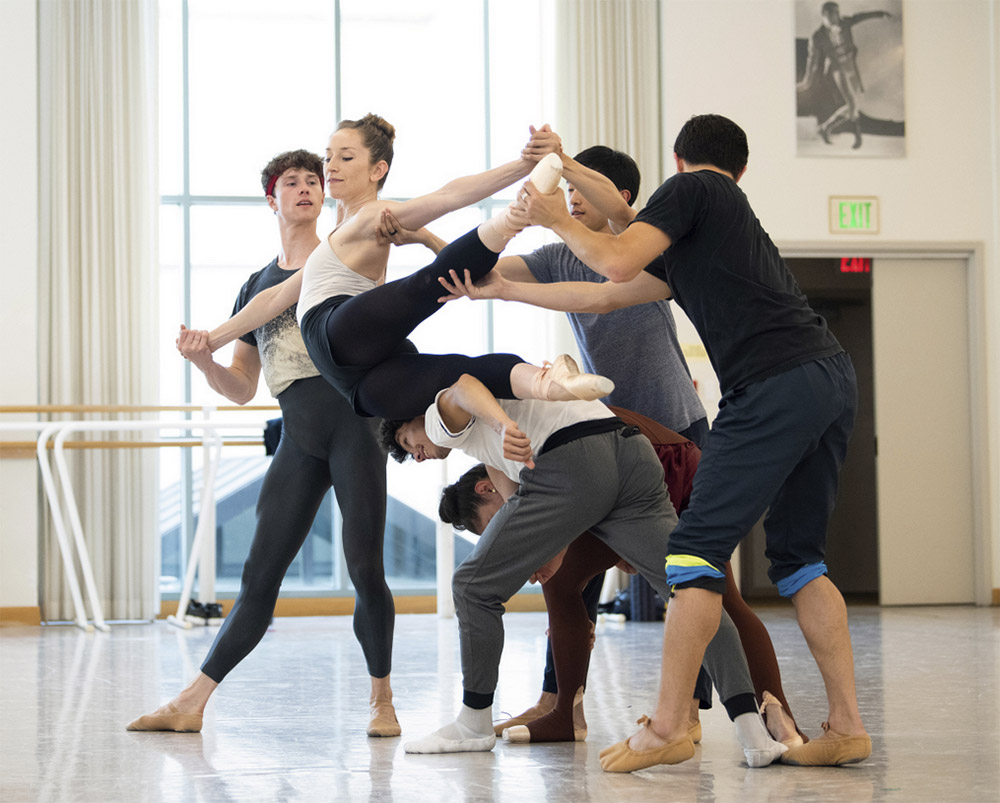
© Erik Tomasson. (Click image for larger version)
I think that’s part of why your work is so effective, because you’re able to read the dancers in the room and bring out the best in those individuals.
I think I’ve finally discovered, in any medium I’m working in with other people, that what I get out of it is the relationship. This might be weird to say, but I think my happiest relationships are with people I’m working with artistically. I really love working with an idea with people, but I also love the privilege of a certain kind of openness, and learning about someone in that way. Sometimes with choreography, it gets boiled down to steps, but steps are easy to come by. It’s more of a true idea or emotion or aspect of a person – getting to that is a little bit trickier, and it’s a wonderful privilege to get access to as a collaborator. That’s what I really get out of it, more even than the finished product.
You’re a filmmaker and a photographer, and I felt like the visual aspect of The Big Hunger is so strong. I kept seeing the opening of Metropolis in the first section – you’re moving all these people around in an almost Soviet-workout format. And there’s some jazzy, Robbins-y West Side Story stuff in it.
My greatest inspiration has always either come from visual art or film … so I always think of the stage through the lens of a filmmaker. I have a photography mentor, and he’s been encouraging me to fill the frame not with an entire body, but with just an eyeball. That actually makes me look at detail in the studio in a different way. Not necessarily more meticulous, because I always have been, but just examining different details. And editing a documentary (2018’s Gravity Hero) helped me slow my brain down, to carry that into the studio and give it the care that it deserves.
You’re taking the dancers to different places, rolling on the floor, up and down – every dimension of physical space is being used in some way, at some point. And every dimension of bodily space is getting utilized. Nothing is off limits – you may not decide to use everything, but it feels like your creative palette is not proscribed. There are classical steps, but there are clearly steps that are invented by the bodies in the room.
I don’t know that that is super-conscious, but I think the shift in me has to do so much with the concept of the piece, and internal shifts I’m having about reality. I started choreographing so young, so there’s so much built-in from being young about what it is to be in the studio. So much of it has to do with ego, and being accepted, and the need to be successful, and as all of those trappings fall away, it’s so much easier and more joyful now to just appreciate what’s really happening in the room. And that allows for so much more creativity.
Thank you, Trey. I can’t wait to see it onstage.
Thank you.








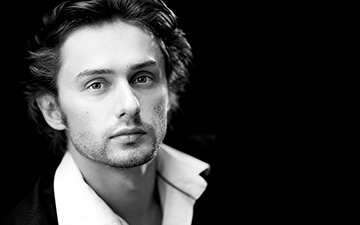


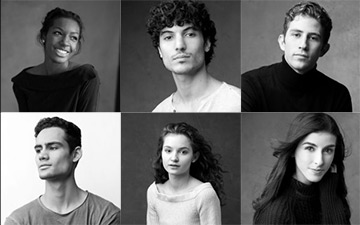


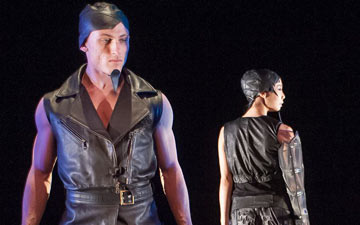
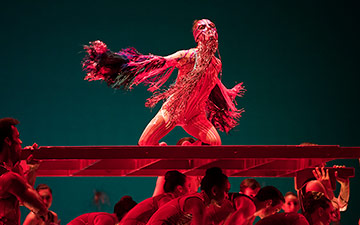

You must be logged in to post a comment.